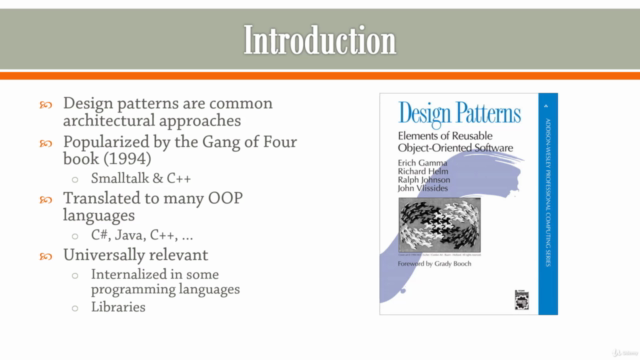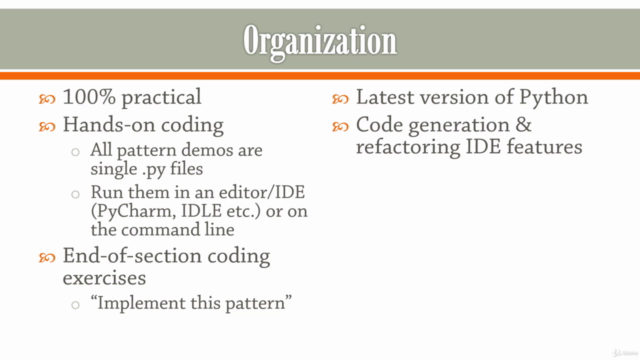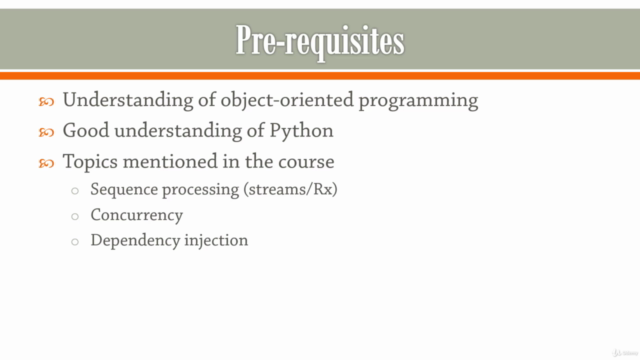Design Patterns in Python

Why take this course?
🌟 Course Overview: Design Patterns in Python 🌟
Dive into the world of modern software design with our comprehensive course on Design Patterns in Python. This course offers an in-depth, practical exploration of design patterns using the latest Python features and contemporary programming techniques. You'll gain hands-on experience with dependency injection, reactive programming, and other modern practices, all while leveraging powerful developer tools like JetBrains PyCharm.
📚 What Are Design Patterns? 📚
Design patterns are time-tested, reusable solutions to common software design problems. Popularized by the seminal work "Design Patterns: Elements of Reusable Object-Oriented Software" by Erich Gamma, John Vlissides, Ralph Johnson, and Richard Helm—the GoF—design patterns are not just a C++ or Smalltalk concept. They have been seamlessly integrated into various programming languages, including Python, C#, Java, JavaScript, and more. These patterns help us write more organized, maintainable, and efficient code by providing templates that can be applied to solve recurring problems without reinventing the wheel.
📊 What Patterns Does This Course Cover? 📊
This course meticulously covers all the GoF design patterns, ensuring you have a full understanding of these fundamental concepts. Here's a sneak peek at what you'll learn:
- SOLID Design Principles: Master the principles that make code more robust and maintainable.
- Creational Design Patterns: Explore patterns like Builder, Factories (Factory Method and Abstract Factory), Prototype, and Singleton.
- Structural Design Patterns: Understand how Adapter, Bridge, Composite, Decorator, Façade, Flyweight, and Proxy enhance your code's structure.
- Behavioral Design Patterns: Learn how Chain of Responsibility, Command, Interpreter, Iterator, Mediator, Memento, Observer, State, Strategy, Template Method, and Visitor can influence the behavior of your applications.
👩💻 Who Is the Course For? 👨💻
This course is tailored for Python developers eager to implement design patterns in a modern context. Whether you're looking to refactor legacy code, design scalable systems, or simply understand how design patterns are applied in Python today, this course will guide you through the process with real-world examples and practical applications.
🖥️ Presentation Style 🖥️
Experience a dynamic learning journey with this course presented as a series of live demonstrations in JetBrains PyCharm, brought to life using the Kinetica rendering engine. This approach minimizes distractions and allows you to focus on the code, whether you're watching on a large screen or a mobile device.
Most demonstrations are self-contained within a single file, which you can download and run in PyCharm, IDLE, or your preferred IDE. This ensures that you can follow along and apply what you learn directly to your own projects. The course does not rely on UML class diagrams; instead, all concepts are demonstrated through live coding sessions.
Join us on this journey to master design patterns in Python and elevate your coding skills to new heights! 🚀
Course Gallery




Loading charts...
Comidoc Review
Our Verdict
Design Patterns in Python is a solid course that covers essential design principles, with real-world relevance and practical examples. Although some exercises could benefit from enhancements, such as improved clarity in exercise descriptions, the course content proves valuable for those looking to refine their Python skills further. Despite occasional lapses in best coding practices throughout the course, overall, it serves as a robust introduction to numerous design patterns within the Python ecosystem.
What We Liked
- Comprehensive coverage of design patterns in Python
- Incorporation of SOLID principles
- High-quality examples to illustrate concepts
- Real-world relevance and applicability of design patterns
Potential Drawbacks
- Some examples are overly complex or not Pythonic
- Exercises could be more challenging and varied
- Occasional lapses in best coding practices by the instructor
- Improved explanation needed on when to use specific patterns